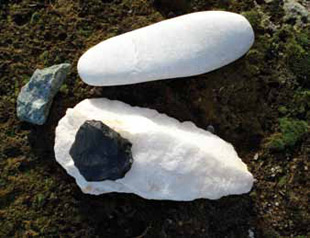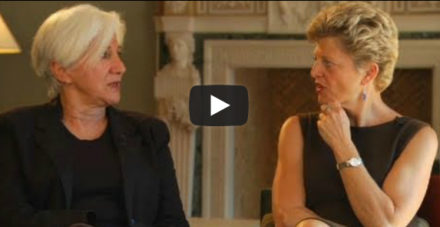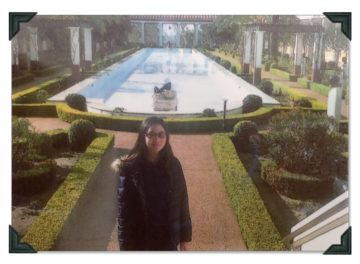Art historian and archaeologist Nigel McGilchrist is taking us to the Aegean—and you can come along! On January 13, he’ll give a free illustrated talk at the Getty Villa on his nearly seven years exploring seventy of these beautiful islands, explaining how their unique geography engendered revolutions in ancient art, science, and politics. Here’s a taste of what he experienced.
We live in a city-centric world. When we think of the scattered islands of the Aegean Sea, we think of them as remote and peripheral, places of retreat where we can “get away from things.” To the ancients it was not so.

The Strait of Telendos in the Aegean Islands, Greece. Photo: Nigel McGilchrist
In the Bronze Age, the Aegean Islands and the sea-routes that linked them were the beating heart of their world—vital stepping-stones between two continents, Europe and Asia, and between two great seas, the Euxine (Black Sea) and the Eastern Mediterranean. At that time and throughout later antiquity, the sea was of central importance—much richer in possibility than the dangerous and often infertile landmasses that bordered it.
From earliest times, tiny, sea-girt Delos, in the middle of the Aegean, was the cosmopolitan heart of the Greek-speaking world, as well as birthplace of two of its greatest divinities: Apollo and Artemis. In the 6th century B.C. the island city of Samos was a bigger and more vital trading center than Athens could then dream of being. Socrates, in his dialogue the Phaedo, put it in a nutshell when he implied that the Greek world was a pond scattered with frogs: the pond was the Aegean, the frogs the Greek cities. The frogs could never have existed without their pond—the life-giving expanse of water that united and separated them at one and the same time.
The Aegean world, once seen, is never forgotten. It is an extraordinary combination of mountains, winds, turbulent waters, idiosyncratic vegetation, and brilliant light; and it has created a way of thinking, of living, of perceiving the universe, which is quite unlike that of the other great cradles of civilization—the calm, fertile valleys of the Euphrates, the Tigris, and the Nile. I spent over six years of my life walking the islands of the Aegean—all 70 of them: the inhabited ones, at least.
Yes, I certainly felt compelled by that divine and majestic landscape. But it was also because I sensed that our reading of Greek history, and therefore of early Western civilization, was skewed unnecessarily towards the centers of mainland Greece.
Nobody would sensibly deny the huge importance and achievements of Athens; but should we, by the same token, overlook the contributions to the arts and sciences, and to the evolution and thinking of the Hellenic world, of Lesbos, Samos, Naxos and Paros in the 7th to 5th centuries B.C., or of Cos and Rhodes in the 5th to 3rd centuries B.C.? Up until only a few decades ago, the Islands were difficult to visit, and remained unexplored and little understood for that reason. It is time to redress the balance.

The Greek island of Karpathos showing the village of Olympos with Mt. Prophitis Elias rising behind. Photo: Nigel McGilchrist
My personal marathon of walking, sailing—sometimes climbing, and even swimming—this remarkable island-world began with a commission to write a brand new Blue Guide to the Aegean Islands. “Four hundred pages,” the publishers said.
I began with Kythera; then Chios, Thasos, and Samothrace. Already there were nearly 250 pages of material. By the time I had completed the book there were over 1,500 pages, and my publishers had lost hope. But the full text has now appeared in 20 small volumes covering individual islands or small island groups.

Marble from the island of Paros, obsidian from Milos, and emery from Naxos. Photo: Nigel McGilchrist
When you are involved in a project like this, the customary reading of history itself begins to alter in front of your eyes. I came to the island of Milos fairly late in my research. In museums all over the Aegean area (and further afield in Malta, Italy, and Egypt) I had seen, again and again, Neolithic tools and blades made from the pure and unmistakable volcanic obsidian of Milos.
But to stand on a grassy hilltop above the harbor of Milos, and to see the piles of discarded obsidian pieces lying exactly where they were dumped five, six, seven thousand years ago, and to realize that Neolithic traders set off from this one point in sailless coracles to paddle along sea-currents from island to island, past deserted coastlines to distant shore-side settlements, in search of purchasers for their curious “black gold”—to witness the origin of all that in one place, is wonderfully moving. It was the beginning of sea-borne commerce in Greece.
It was also the beginning of the tradition of Western sculpture. When that micro-sharp obsidian from Milos came to the island of Naxos, home of a soft and exquisite, crystalline white marble, it was a marriage made in heaven; and the progeny was the wealth of tiny figurines of unmistakable craftsmanship which we call Cycladic sculpture.

Cycladic sculpture made of marble: Pregnant Female Figure, attributed to the Schuster Master, about 2400 B.C. 16 in. high. The J. Paul Getty Museum, 90.AA.114
That sculpture is not Egyptian in inspiration, or Mesopotamian, or Cretan: it is proudly and independently Aegean for the first time—the origins of a much later and truly Greek art.
What is seen so clearly in the Islands, is the way in which the art and history are driven by the geography, by the availability of materials—and by that unpredictable facilitator of communication, the all-surrounding sea.
The sheer, exhilarating beauty and boldness of the natural sites which the Island Greeks, throughout their whole history, chose for their settlements and for their sanctuaries is one of the abiding joys of the Aegean world. The substantial amount of new archaeological work underway in the Aegean constantly reinforces that the islands were busy, well-populated, and intimately connected with one another from the Early Bronze Age right through into late antiquity.
The last decade—the period in which I have been working on these books—has seen a ferment of archaeological and historical activity in the Islands. Perhaps the old imbalance in our perception of the Greek world is slowly being redressed after all.
To read more about Nigel McGilchrist’s Aegean adventures, see “World Travel: Aegean Odyssey” in issue 44 of Current World Archaeology magazine; you can download the article as a PDF here. Thanks to the author and Current World Archaeology for permission to provide this article.
Text of this post © Nigel McGilchrist. All rights reserved.




Nigel, Sounds like you have lots of interesting projects going on – as always. Would love to reconnect. I was just at Oxford last week and was thinking of you and the immense impact you had that summer term…